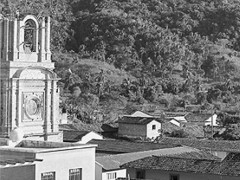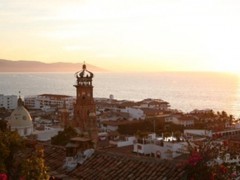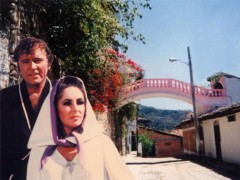Back to list of articles



|
History of Puerto Vallarta
The bay served for many years as a safe refuge for ships from Pacific storms and as a place to get fresh water and food, but it was also used by pirates hiding and attacking Spanish galleons. Legend says that the now popular Playa los Muertos was named after a bloody battle between pirates and local Indians, where there were many casualties, but some other people believe that it was a place where the Indians buried their dead.
During the colony period the development came in the form of silver mines high in the Sierra Madre Mountains in San Sebastian, Talpa de Allende and Mascota.
The first town, according to historians, was found in 1851 by Guadalupe Sánchez Torres when he brought his family to live close to the Cuale River and named the town “Las Peñas”. By 1880 the population had reached 1,500 people. The town of “Las Peñas” was officially recognized as a municipality in 1918 and the name was changed to honor former Jalisco governor, Ignacio L. Vallarta.
Puerto Vallarta remained a quiet fishing and agriculture town attracting workers from the Sierra towns and looking for a place to settle and jobs.
It was around the 1950’s that Vallarta started attracting Americans, mostly artists looking for a retreat away from the USA, and the Gringo Gulch began its development as an expatriate neighborhood on the hill above downtown. But it was not until 1954 when Mexicana Airlines started flying to Vallarta, and many Mexican and International tourists began to discover the area.
The filming of the “Night of the Iguana” in 1963, directed by John Huston, helped position Puerto Vallarta on the map for US tourists, as the media gave extensive coverage to Elizabeth´s Taylor affair with Richard Burton.
During the late 1960’s and early 1970’s, the Mexican government invested in the development of highways, airport and utility infrastructure, making Puerto Vallarta easily accessible both by air and ground transportation for the first time. The city's first tourist boom occurred in the late 1960s and early 1970s because of these development projects.
|
|
The Spanish first arrived to the area in 1524 led by Francisco Cortes. It is said that when they entered the valley they were met by more than 20,000 thousand Indians holding a simple feather flags, reason why the Spanish named the region “Valley of the Flags” (Valle de las Banderas).
|
|
In 1968 the municipality was officially recognized as a city, from that moment, Vallarta has grown intensively not only in economic terms but also in its cultural richness to become one of the favorite tourist destinations for both national and international visitors.
|
|
|
|
|

